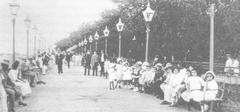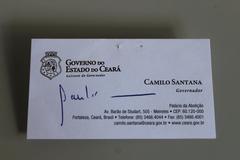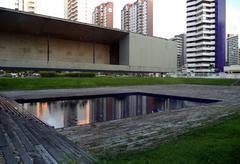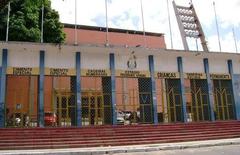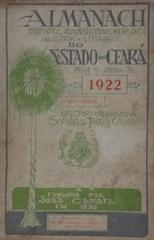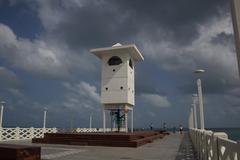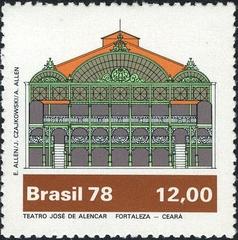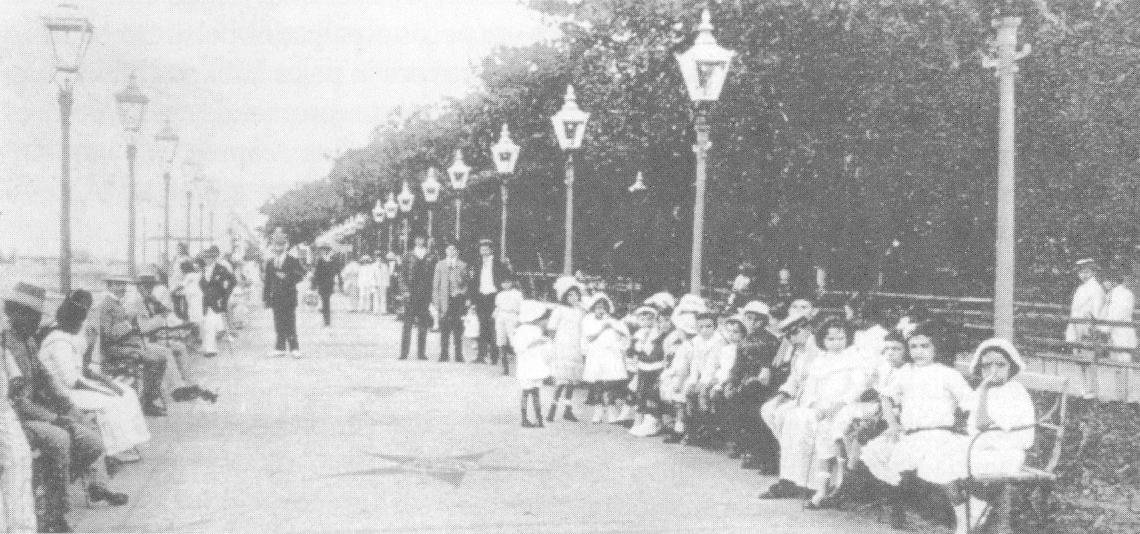
Visiting Praça Dos Mártires: Hours, Tickets, and Tips
Published Date: 18/08/2024
Introduction to Praça Dos Mártires
Welcome to this comprehensive guide on visiting Praça dos Mártires, also known as Passeio Público, located in Fortaleza, Brazil. This historical gem is not only the oldest square in the city but also a significant cultural and social landmark. Constructed in 1864 and designed by Silva Paulet in the 1890s, the square has evolved over the years, reflecting the rich history and cultural transitions of Fortaleza (Wikipedia). Initially known as Campo da Pólvora due to its use as a gunpowder storage site, it was later renamed Praça da Misericórdia before adopting its current name in 1879 to honor the martyrs of the Confederação do Equador (iPatrimonio).
Praça dos Mártires has witnessed significant historical events, including the execution of revolutionary leaders in 1825 and the first football matches in the state, played by sailors, English residents, and local elites (Wikipedia). Despite facing periods of neglect, the square was revitalized in the 2000s and now serves as a peaceful retreat for both locals and tourists (Lazer em Foco). With its neoclassical architecture, lush greenery, and cultural events, Praça dos Mártires offers a unique blend of history, culture, and natural beauty. This guide will provide you with all the information you need for a successful visit, from historical context and visiting hours to travel tips and nearby attractions.
What You’ll Find in This Guide
- History of Praça dos Mártires
- Early Beginnings and Construction
- Naming and Historical Significance
- Architectural Evolution
- Decline and Revitalization
- Cultural and Social Impact
- Natural Attractions
- Visitor Information
- Visiting Hours
- Tickets
- Travel Tips
- Best Time to Visit
- Safety
- Amenities
- Nearby Attractions
- Fortaleza Cathedral
- Dragão do Mar Center of Art and Culture
- Central Market
- Accessibility
- Modern-Day Significance
- Preservation Efforts
- FAQ
History of Praça dos Mártires
Early Beginnings and Construction
Praça dos Mártires, also known as Passeio Público, is the oldest square in Fortaleza, Ceará. Its origins date back to 1864 when it was initially constructed. The square was designed by Silva Paulet in the 1890s, under the governance of José Félix de Azevedo e Sá. The area was initially known as Campo da Pólvora due to its use as a gunpowder storage site (Wikipedia).
Naming and Historical Significance
The square has undergone several name changes throughout its history. Initially called Campo da Pólvora, it was later renamed Praça da Misericórdia. Its current name, Praça dos Mártires, was adopted on January 11, 1879, by the Câmara Municipal de Fortaleza. This name was chosen to honor the martyrs of the Confederação do Equador, a separatist and republican movement against the government of Emperor Dom Pedro I. The movement’s leaders, including Azevedo Bolão, Feliciano Carapinima, Francisco Ibiapina, Padre Mororó, and Pessoa Anta, were executed at this location in 1825 (iPatrimonio).
Architectural Evolution
The square was constructed in a neoclassical style in 1890 and underwent significant renovations in 1940, modeled after the Passeio Público in Rio de Janeiro. These renovations included the addition of a skating rink and a space for quermesse fairs, making it a popular gathering spot for the city’s youth (Wikipedia).
Decline and Revitalization
During the 1990s, Praça dos Mártires experienced a period of neglect, becoming a hotspot for drug trafficking and prostitution. This led to a decline in its use by the general public. However, a revitalization project in the second half of the 2000s restored the square to its former glory. Today, it is once again a vibrant and peaceful space, frequented by both locals and tourists (Lazer em Foco).
Cultural and Social Impact
Praça dos Mártires has played a significant role in the cultural and social life of Fortaleza. It was the site of the first football matches in the state, played by sailors from anchored ships, English residents, and local elites. The square also served as a meeting place for abolitionist groups and hosted various public events (Wikipedia).
Natural Attractions
One of the most notable features of Praça dos Mártires is its natural beauty. The square is home to several centenarian trees, including a famous baobab planted by Senator Pompeu in 1910. These trees provide a serene and shaded environment, making the square an ideal spot for relaxation and leisure (Pordentro dos Parques).
Visitor Information
Visiting Hours
Praça dos Mártires is open to the public every day from 6:00 AM to 10:00 PM. These extended visiting hours ensure that both early birds and night owls can enjoy the square’s serene atmosphere.
Tickets
Entrance to Praça dos Mártires is free of charge, making it an accessible and budget-friendly destination for all visitors.
Travel Tips
- Best Time to Visit: Early morning or late afternoon to avoid the midday heat and enjoy a more tranquil experience.
- Safety: While the square has been revitalized, it is always advisable to stay vigilant and keep personal belongings secure.
- Amenities: Restrooms and seating areas are available throughout the square.
Nearby Attractions
- Fortaleza Cathedral: A stunning neo-Gothic cathedral located just a short walk from the square.
- Dragão do Mar Center of Art and Culture: Offers a variety of cultural experiences, including museums, theaters, and art galleries.
- Central Market: Ideal for shopping and experiencing local cuisine.
Accessibility
Praça dos Mártires is accessible to visitors with disabilities. Ramps and designated pathways ensure ease of movement for all guests.
Modern-Day Significance
Today, Praça dos Mártires continues to be a significant cultural and historical landmark in Fortaleza. It offers a tranquil environment with lush greenery and a beautiful view of the sea. The square is also home to the Café Passeio, a popular restaurant that serves a variety of dishes, including traditional Brazilian cuisine (Pordentro dos Parques).
Preservation Efforts
The square was officially listed as a protected site by the Instituto do Patrimônio Histórico e Artístico Nacional (IPHAN) on April 13, 1965. This designation has helped preserve its historical and cultural significance, ensuring that future generations can continue to enjoy this important landmark (iPatrimonio).
FAQ
- What are the visiting hours? Praça dos Mártires is open daily from 6:00 AM to 10:00 PM.
- Are guided tours available? Yes, guided tours can be arranged through local tour operators.
- Is there an entry fee? No, entrance to the square is free.
- What nearby attractions can I visit? Fortaleza Cathedral, Dragão do Mar Center of Art and Culture, and Central Market are all nearby.
Conclusion
Praça dos Mártires stands as a testament to the rich history and cultural evolution of Fortaleza. From its early beginnings as a gunpowder storage site to its current status as a beloved public space, the square has witnessed significant historical events and social changes. Its preservation and revitalization efforts have ensured that it remains a vital part of the city’s heritage, offering a peaceful retreat for residents and visitors alike. Be sure to visit Praça dos Mártires during your next trip to Fortaleza to experience its historical charm and natural beauty firsthand.
Further Reading and Sources
- Wikipedia. (n.d.). Praça dos Mártires. Retrieved from Wikipedia
- iPatrimonio. (n.d.). Fortaleza Antiga: Praça dos Mártires. Retrieved from iPatrimonio
- Lazer em Foco. (2019, May 9). Praça dos Mártires: A mais antiga e bonita de Fortaleza. Retrieved from Lazer em Foco
- Pordentro dos Parques. (n.d.). Praça dos Mártires. Retrieved from Pordentro dos Parques
- Brazil Travel Guide. (n.d.). Fortaleza Travel Guide. Retrieved from Brazil Travel Guide
- Culture Trip. (n.d.). Top 10 Tips for Staying Safe in Fortaleza. Retrieved from Culture Trip
- Brazil City Guides. (n.d.). Fortaleza Travel Guide. Retrieved from Brazil City Guides
- Praias de Fortaleza. (n.d.). Praça dos Mártires. Retrieved from Praias de Fortaleza
- Mapa Cultural. (n.d.). Retrieved from Mapa Cultural
- The Travel Editor. (2024). What to Do in Fortaleza, Brazil: Ultimate Guide. Retrieved from The Travel Editor
- Bite Size Brazil. (n.d.). Things to Do in Fortaleza, Brazil. Retrieved from Bite Size Brazil
